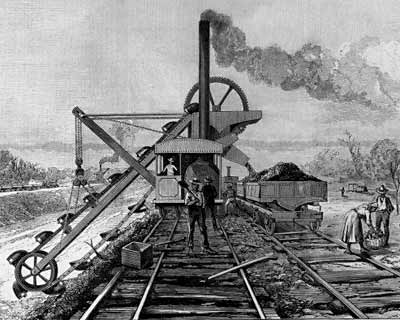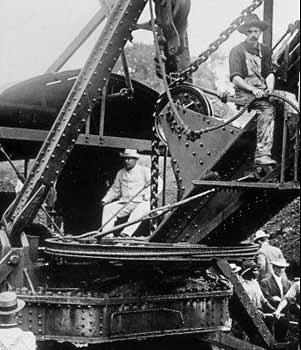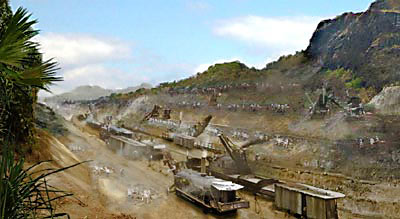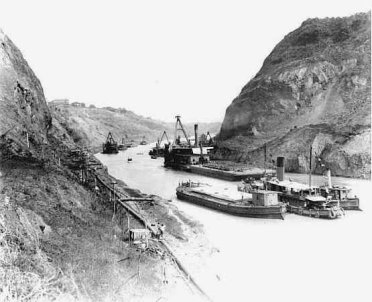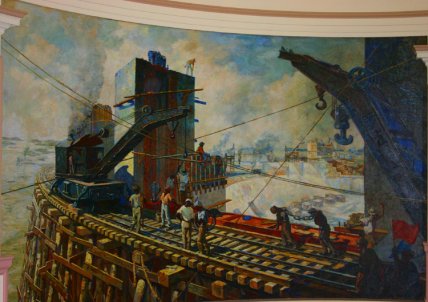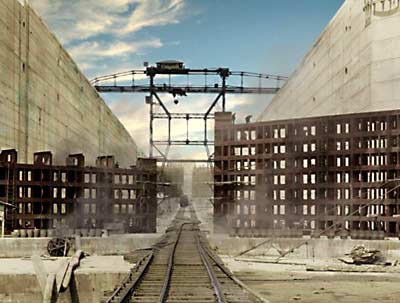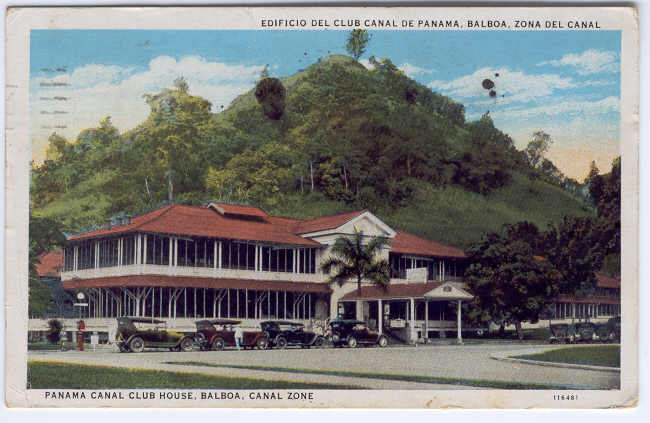Destiny’s Canal
Path Between the Seas, The Creation of the Panama Canal, David McCullough, 1977
Epic tale of the efforts of the French and Americans to create the long desired passage between the Atlantic and Pacific oceans. President Grant sent survey teams to find the best route in 1870 but nothing further was done by the U.S. to attempt to build a canal. Instead, the French, following their engineering and financial success at Suez, raised private money under the leadership of Ferdinand de Lessep, hero of Suez, who insisted a sea level canal be built in Panama. The French effort was under-funded and plagued with problems, not least of which was disease. Further efforts to raise money failed and the company was thrown into bankruptcy. Scandals at the highest level were uncovered with newspaper payoffs and political bribes but only Charles Lessep, son of Ferdinand, and one other minor player were ever sent to jail. The effort ended in 1889.
Teddy Roosevelt became President in 1902 and immediately set out to build the canal. He left it to Congress to decide the best route, although Nicaragua was assumed to be favored. Enter Philip Bunau Varilla, a French engineer of the earlier French effort and influence peddler William Cromwell who set out to convince Congress that Panama was the better route and that the U.S. should buy the French assets including rail and digging excavators at $109 Million. When it appeared they would lose, the French lowered the price to $40 Million and TR became interested, thinking this purchase would speed the completion of a canal. Two volcanic eruptions, one on Martinique and one in Nicaragua convinced Congress to vote for Panama.
Secretary of State John Hay (former private secretary to Lincoln (star with Henry Adams of Gore Vidal’s Empire ) immediately negotiated a new canal treaty with Columbia but after months of delay, the Colombian Legislature rejected the treaty in spite of the offered $10 Million immediate payment. Bunau Varilla, with Hay and TR working behind the scenes engineered a coupe in Panama with American naval support (gun boat diplomacy) so that Columbia could not land troops to regain control. TR asked his Attorney General to construct a legal defense for his actions, but Attorney General Knox replied:
Oh, Mr. President, do not let so great an achievement suffer from any taint of legality.
When TR trying out a defense during a cabinet meeting demanded “Have I defended myself?” Elihu Root responded:
You certainly have, Mr. President. You have shown that you were accused of seduction, and you have conclusively proved that you were guilty of rape.
Bunau Varilla was named special envoy to negotiate a canal treaty and Bunau Varilla wrote a draft totally favorable to the U.S. Hay recognized Panama as an independent country, signed the canal treaty and Congress ratified the treaty immediately. Panama hesitated to sign until Hay threatened to pull the navy back. The $10 Million went to JP Morgan to hold for Panama who invested most of it in New York real estate. The French got their $40 Million. McCollough reminds us that American Imperialism was largely the result of purchases (Louisiana, Alaska, Philippines) and was never considered to be imperialist as a consequence.
Heroes of Panama were William Gorgas who understood the role of mosquitoes as carriers of Yellow Fever and Malaria and who headed the health and sanitation efforts that came close to eradication these two killers. He had previously done the same in Cuba. John Stevens had built the Great Northern railway, discovering the Marias pass and the Stevens pass, giving the Great Northern the lowest elevation trans continental route. Stevens immediately saw that the keys to Panama were eradication of disease and building railroads capable of hauling the excavation debris away from the cuts. He spent a couple years building housing, hospitals, harbors, and railroads before any major excavation could start. He resigned at this point.
Colonel George Goethels of West Point was then appointed as the virtual dictator of Panama. TR knew that the military man would complete his mission and not resign.
The choice between a sea level and lock and lake canal was not made until 1907. The canal was designed then to accommodate the Titanic, the largest ship of the time. The locks were 1000 feet by 102 feet. The size of the canal was to dictate the maximum size of ships for decades including aircraft carriers of the navy. Only the Queen Mary and Queen Elizabeth were too large for the canal. Modern oil tankers are far too large. The lock and lake design meant damming two rivers on the Atlantic and Pacific sides.
The dams had the side effect that electric power could be made available for everything in the canal zone and in the entire country. The canal pioneered electrical trains, locks, and much else. The Culebra Cut, a nine mile stretch at the highest elevation, was the biggest challenge given the massiveness of the cut and the continuous land slides. Even after the canal opened, slides would close the canal for months at a time.
The canal became a major tourist attraction while it was being built with hundreds of thousands of visitors. The canal opened simultaneously with the outbreak of WWI in 1914 and ceremonies were canceled. The first crossing was by one of canal’s own freight ships and was hardly noticed.
The physical and social structure of the canal zone comes in for detailed scrutiny with some suggesting the canal was actually a socialist system. It is probably more correct to look at the canal zone as a very large military base before the days of outsourcing with its rigid hierarchical structure and completely self contained infrastructure, even though most residents and workers were civilian and not military. In any event the canal zone was a model of efficiency virtually without corruption, nepotism, or fraud, a remarkable achievement. In this way, the canal zone stands as a shining beacon of American know how in sharp contrast to today’s Baghdad Green Zone where waste, nepotism, cronyism, fraud, and incompetence are the only way of life.
